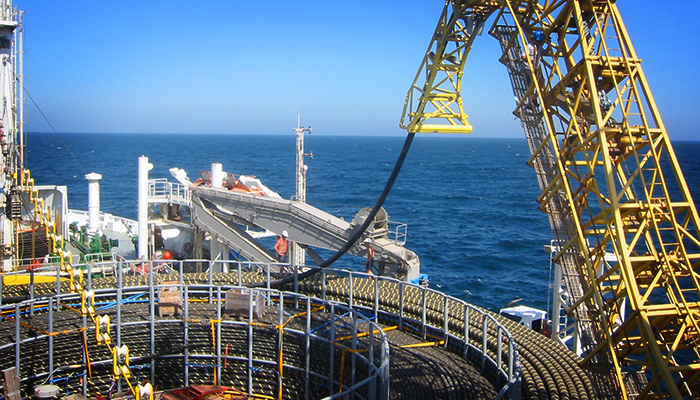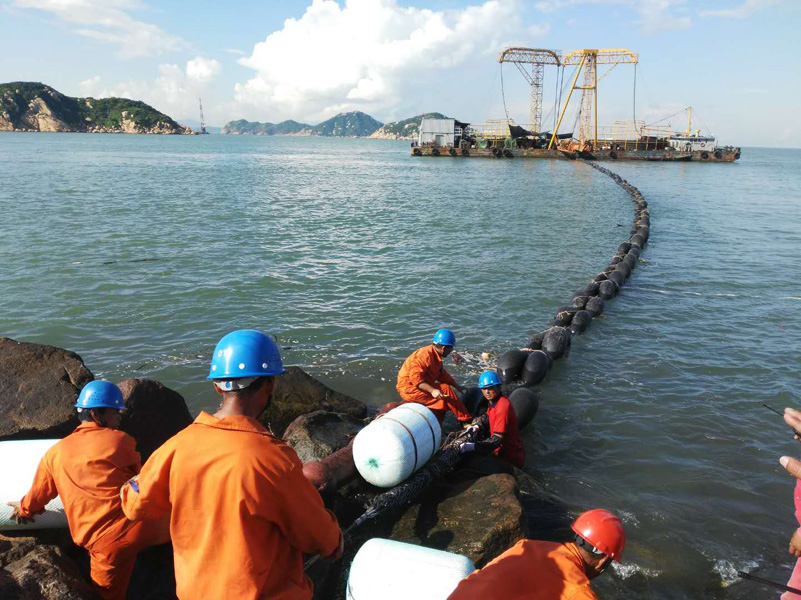It is reported that the Myanmar-Singapore International Submarine Fiber Optic Cable Laying Project will be under construction for more than five consecutive months in the Myanmar Special Economic Zone.
Basic information on the construction of the submarine cable
Construction of the first Singaporean private sector-operated submarine cable in Myanmar began at the beginning of the year and is now in the final stages of completion and use.
This is another submarine cable project that will be a further step in communications cooperation between the two regions.
The laying of submarine fiber optic cables is not just as simple as land-based cables.

Submarine Cable Laying
The laying of submarine cables is done by fixing one end of the fiber optic cable on the shore, and the ship is slowly driven out to sea, sinking the fiber optic cable or cables to the bottom of the sea while laying them using an excavator that sinks to the bottom of the sea.
Two important pieces of equipment are mentioned here: the fiber optic cable ship and the submarine excavator.
1 Set up trans-oceanic fiber optic cable need fiber optic cable ship
Before laying, do a good job of cable routing survey and cleanup, fishing gear and residue cleanup, sea boat trenching, marine navigation information release, safety precautionary measures, and other work. The cable-laying construction vessel is fully loaded with submarine cables and arrives at the designated laying sea area about 5.5 km away from the terminal station. The cable-laying construction vessel docked with another auxiliary construction vessel and started to reverse the cable, transferring part of the cable to the auxiliary construction vessel.
The deep-sea part of the cable laying is done by a power positioning vessel equipped with fully automated construction equipment such as underwater remote-controlled robots and automatic positioning to accurately lay the cable to the designated route location.
2 The other part is the submarine excavator
It is initially placed on the shore and connected to the fixed end of the fiber optic cable. Its role is a bit like a plow for plowing, for fiber optic cables, it is the counterweight that allows the fiber optic cable to sink to the bottom of the sea.
Simply put, the fiber optic cable laying vessel puts the cable in place, while the excavator lays the cable. But transoceanic fiber optic cables are thicker and less flexible, so the forward speed of the boat should be strictly controlled.
In addition, on the seabed in rough terrain, robots are needed to constantly detect the best path to prevent rocks from damaging the fiber optic cable.
The Ministry of Fisheries has issued a notice stating that the passage and mooring of all types of vessels, cargo ships, fishing boats, and motor vehicles, as well as the conduct of fishing or the placement of fishing equipment, are prohibited in the area where the fiber optic cable is being laid.
Impact of fishing activities on submarine fiber-optic cables
Fishing time and the number of nets are increasing year by year, and the number of fishing vessels is also increasing in operational density.
Fishing vessels operate almost all year round, except during closed seasons.
At the same time, with the large-scale development of fishing vessels and fishing gear, the fishing and anchor depth of the profile increased, and the submarine fiber optic cable produced a huge security threat.
1 Impact on submarine cable routing survey
Ensuring the safety of submarine fiber optic cable routing survey a submarine cable is an indispensable part of the fair.
Its purpose is to obtain the ocean and the seabed laying submarine fiber optic cable system needs details, based on the analysis, to find the most reasonable, safe, and economical construction of submarine fiber optic cable routing.
At present, the main content of the submarine fiber optic cable routing survey work is the comprehensive use of shallow exploration, side-scan sonar detection, multibeam bathymetry, and other geophysical exploration methods, to discover the routing area of the water depth, shallow seismic profiles, the seabed surface morphology, and the characteristics of the underwater environment and geological hazards.
For offshore survey operations, the signal source is usually hung on the ship’s side or aft side, pulling the underwater towing mechanism.
In the case of frequent fishing activities, the survey is often difficult to avoid the interference of various fishing vessels, thus affecting the effectiveness of the survey data.
In the actual survey process, there may also be fishing gear hooks, and entangled underwater towing mechanisms leading to equipment failure or even loss of the situation, affecting the survey work.

2 Impact on the safety of submarine fiber optic cable
There are two main aspects of fishing activities: fishing gear and anchor operations.
According to statistics, 75% of fiber optic cable breakage is caused by fishing gear and anchors.
Due to technical constraints, the deep burial depth of submarine cables, sometimes even laid directly on the seabed, is such that the cables are more susceptible to damage from dredging operations, fishing gear, and anchor hooks of fishing vessels.
Moreover, for cost considerations, single armored submarine cables are used, and cable damage and failures occur frequently.
With the improvement of safety requirements for submarine cables and the development of construction technology, submarine fiber optic cable burial depth is gradually deepened. Many shelves of shallow submarine cable depth of 3.0 m or more, greatly reduce the submarine cable damage rate of fishing activities.
3 Fishing activities and mooring operations
With the dwindling of offshore marine fishery resources, in addition to the continuous expansion to deep-sea fishing activities, countries continue to put into production large-scale and more advanced fishery facilities.
In addition to the fact that fishing activities and vessels cause most fiber optic cable failures, natural disasters, including currents and earthquakes, account for about 12% of the total.
Most faults at depths of less than 200 meters are caused by human activities, while the inability to reach depths greater than 1,000 meters is mainly due to natural causes.
Anchoring usually occurs at anchorages, but anchors can also cause damage to submarine fiber optic cable systems during ship emergencies. In the case of submarine fiber optic cable anchoring, it is often a direct result of submarine fiber optic cable rupture.
It is understood that Campana Mythic Co., Ltd will use the underwater fiber optic cable laying vessel, CS. Nusantara Explorer, to carry out the laying and burial work of the fiber optic cable using the first unit of the main fiber optic cable installed by an unmanned Remotely Operated Vehicle (ROV) within the Myanmar Special Economic Zone (SEZ).
The laying work will commence on July 13, 2023, and will continue until the end of December, the Ministry of Fisheries has informed.
A Notice to Mariners (NAM) has been issued in the construction area to prevent any delays in the construction work along the route of the submarine fiber optic cable laying project connecting to the Myanmar Exclusive Economic Zone (MEEZ).
Campana was established in 2014 and is headquartered in Singapore. It is currently working on data network connectivity in Myanmar, Singapore, and Thailand.
